SME International Expansion: Challenges, Solutions, & Psychic Distance
VerifiedAdded on 2023/04/22
|17
|6742
|419
Essay
AI Summary
This essay comprehensively addresses the challenges encountered by small and medium-sized enterprises (SMEs) when expanding internationally, including economies of scale, lack of global operation knowledge, risk-averse behavior, competition, and leadership experience. It further explores how these challenges can be addressed through strategic decision-making, learning curves, and pre-emptive strategies, using examples like Wal-Mart and Apple Inc. The essay also delves into the role of psychic distance in internationalization, examining its impact on market selection, product adaptation, and overall flexibility, illustrated by examples such as McDonald's in the UAE and Nike in China. Additionally, it discusses considerations for choosing a foreign market entry mode and evaluates the challenges and opportunities arising from instability in the international trade regime. This assignment is available on Desklib, where students can find a wealth of study resources and solved assignments.
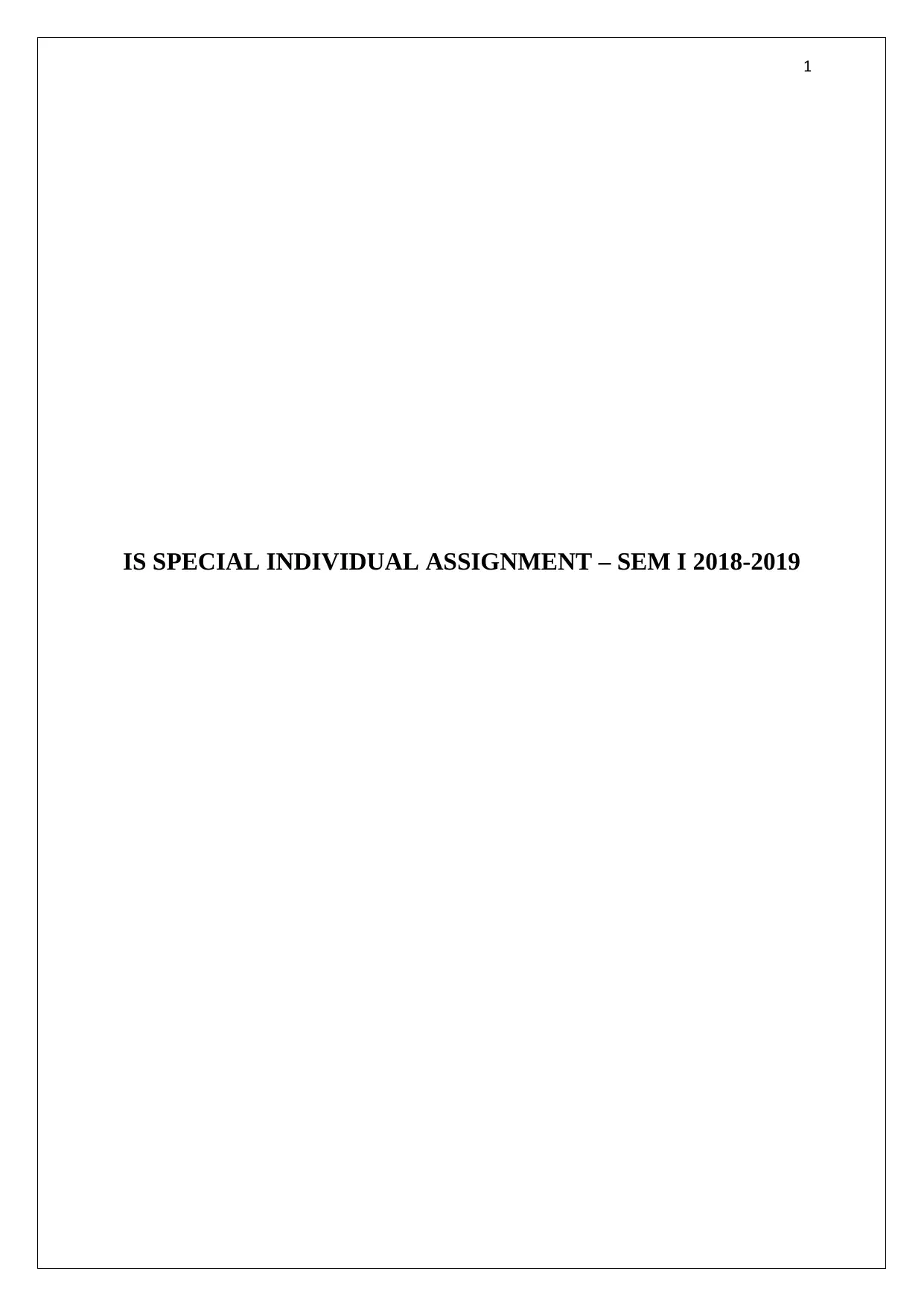
1
IS SPECIAL INDIVIDUAL ASSIGNMENT – SEM I 2018-2019
IS SPECIAL INDIVIDUAL ASSIGNMENT – SEM I 2018-2019
Paraphrase This Document
Need a fresh take? Get an instant paraphrase of this document with our AI Paraphraser
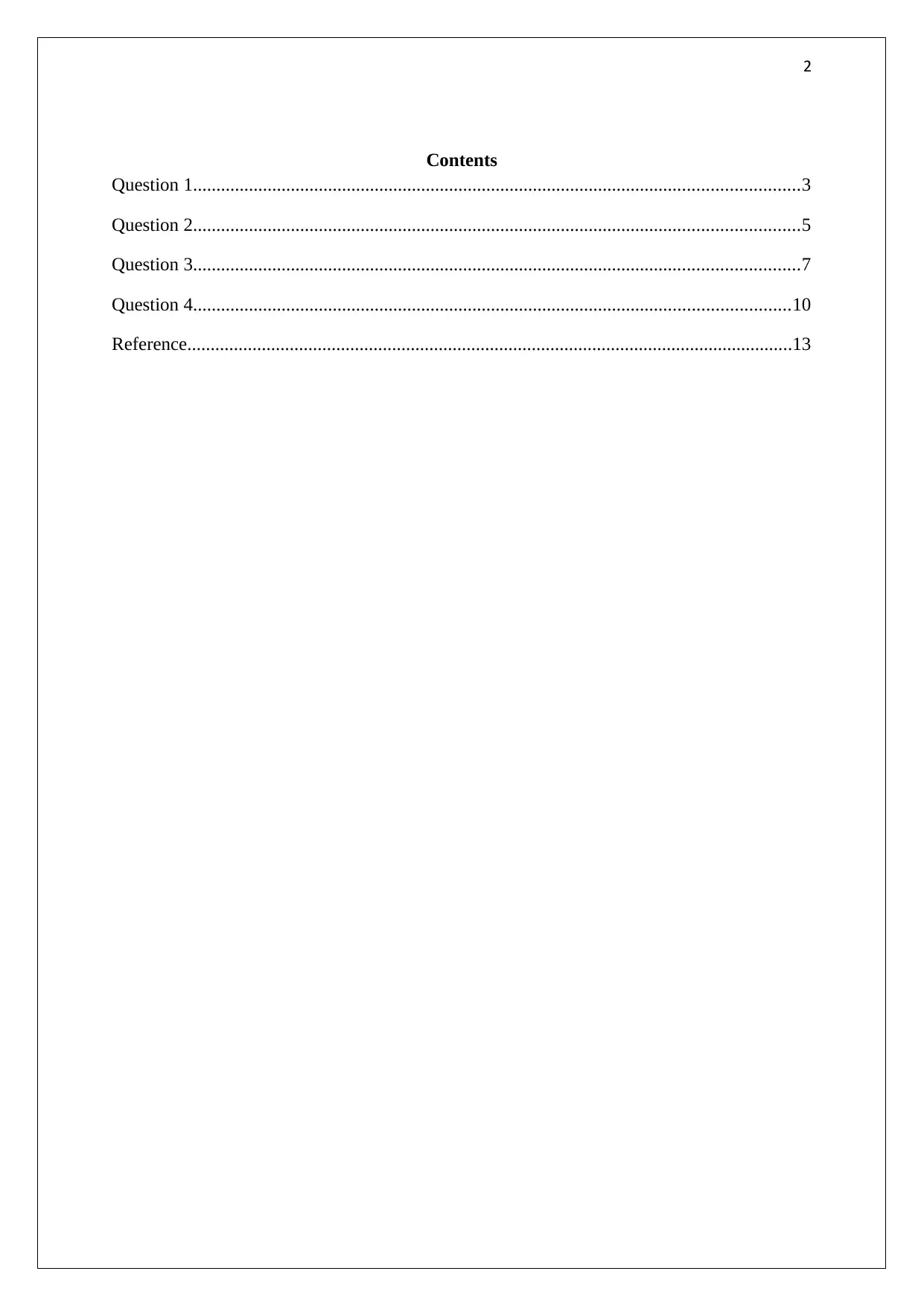
2
Contents
Question 1..................................................................................................................................3
Question 2..................................................................................................................................5
Question 3..................................................................................................................................7
Question 4................................................................................................................................10
Reference..................................................................................................................................13
Contents
Question 1..................................................................................................................................3
Question 2..................................................................................................................................5
Question 3..................................................................................................................................7
Question 4................................................................................................................................10
Reference..................................................................................................................................13
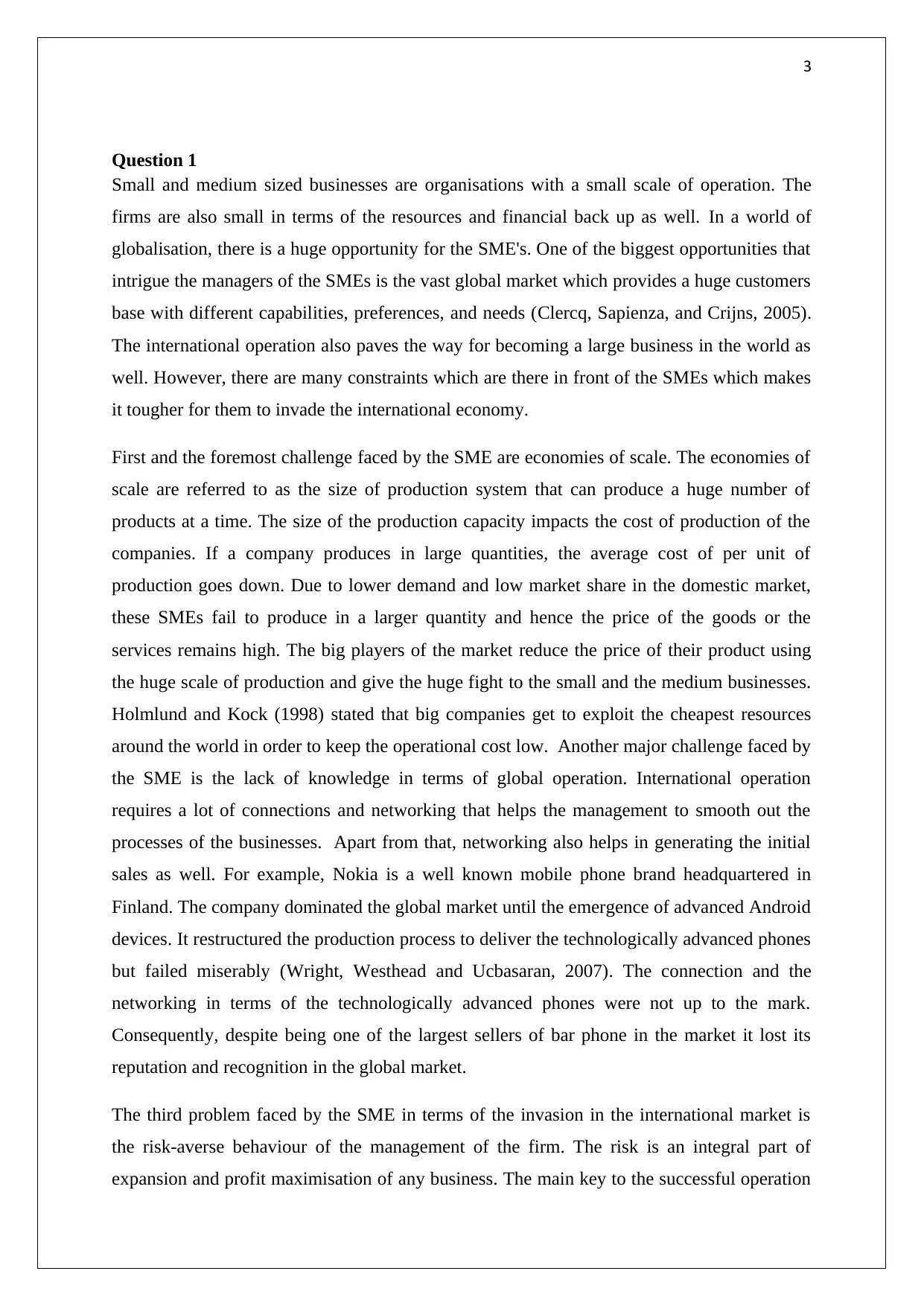
3
Question 1
Small and medium sized businesses are organisations with a small scale of operation. The
firms are also small in terms of the resources and financial back up as well. In a world of
globalisation, there is a huge opportunity for the SME's. One of the biggest opportunities that
intrigue the managers of the SMEs is the vast global market which provides a huge customers
base with different capabilities, preferences, and needs (Clercq, Sapienza, and Crijns, 2005).
The international operation also paves the way for becoming a large business in the world as
well. However, there are many constraints which are there in front of the SMEs which makes
it tougher for them to invade the international economy.
First and the foremost challenge faced by the SME are economies of scale. The economies of
scale are referred to as the size of production system that can produce a huge number of
products at a time. The size of the production capacity impacts the cost of production of the
companies. If a company produces in large quantities, the average cost of per unit of
production goes down. Due to lower demand and low market share in the domestic market,
these SMEs fail to produce in a larger quantity and hence the price of the goods or the
services remains high. The big players of the market reduce the price of their product using
the huge scale of production and give the huge fight to the small and the medium businesses.
Holmlund and Kock (1998) stated that big companies get to exploit the cheapest resources
around the world in order to keep the operational cost low. Another major challenge faced by
the SME is the lack of knowledge in terms of global operation. International operation
requires a lot of connections and networking that helps the management to smooth out the
processes of the businesses. Apart from that, networking also helps in generating the initial
sales as well. For example, Nokia is a well known mobile phone brand headquartered in
Finland. The company dominated the global market until the emergence of advanced Android
devices. It restructured the production process to deliver the technologically advanced phones
but failed miserably (Wright, Westhead and Ucbasaran, 2007). The connection and the
networking in terms of the technologically advanced phones were not up to the mark.
Consequently, despite being one of the largest sellers of bar phone in the market it lost its
reputation and recognition in the global market.
The third problem faced by the SME in terms of the invasion in the international market is
the risk-averse behaviour of the management of the firm. The risk is an integral part of
expansion and profit maximisation of any business. The main key to the successful operation
Question 1
Small and medium sized businesses are organisations with a small scale of operation. The
firms are also small in terms of the resources and financial back up as well. In a world of
globalisation, there is a huge opportunity for the SME's. One of the biggest opportunities that
intrigue the managers of the SMEs is the vast global market which provides a huge customers
base with different capabilities, preferences, and needs (Clercq, Sapienza, and Crijns, 2005).
The international operation also paves the way for becoming a large business in the world as
well. However, there are many constraints which are there in front of the SMEs which makes
it tougher for them to invade the international economy.
First and the foremost challenge faced by the SME are economies of scale. The economies of
scale are referred to as the size of production system that can produce a huge number of
products at a time. The size of the production capacity impacts the cost of production of the
companies. If a company produces in large quantities, the average cost of per unit of
production goes down. Due to lower demand and low market share in the domestic market,
these SMEs fail to produce in a larger quantity and hence the price of the goods or the
services remains high. The big players of the market reduce the price of their product using
the huge scale of production and give the huge fight to the small and the medium businesses.
Holmlund and Kock (1998) stated that big companies get to exploit the cheapest resources
around the world in order to keep the operational cost low. Another major challenge faced by
the SME is the lack of knowledge in terms of global operation. International operation
requires a lot of connections and networking that helps the management to smooth out the
processes of the businesses. Apart from that, networking also helps in generating the initial
sales as well. For example, Nokia is a well known mobile phone brand headquartered in
Finland. The company dominated the global market until the emergence of advanced Android
devices. It restructured the production process to deliver the technologically advanced phones
but failed miserably (Wright, Westhead and Ucbasaran, 2007). The connection and the
networking in terms of the technologically advanced phones were not up to the mark.
Consequently, despite being one of the largest sellers of bar phone in the market it lost its
reputation and recognition in the global market.
The third problem faced by the SME in terms of the invasion in the international market is
the risk-averse behaviour of the management of the firm. The risk is an integral part of
expansion and profit maximisation of any business. The main key to the successful operation
⊘ This is a preview!⊘
Do you want full access?
Subscribe today to unlock all pages.

Trusted by 1+ million students worldwide
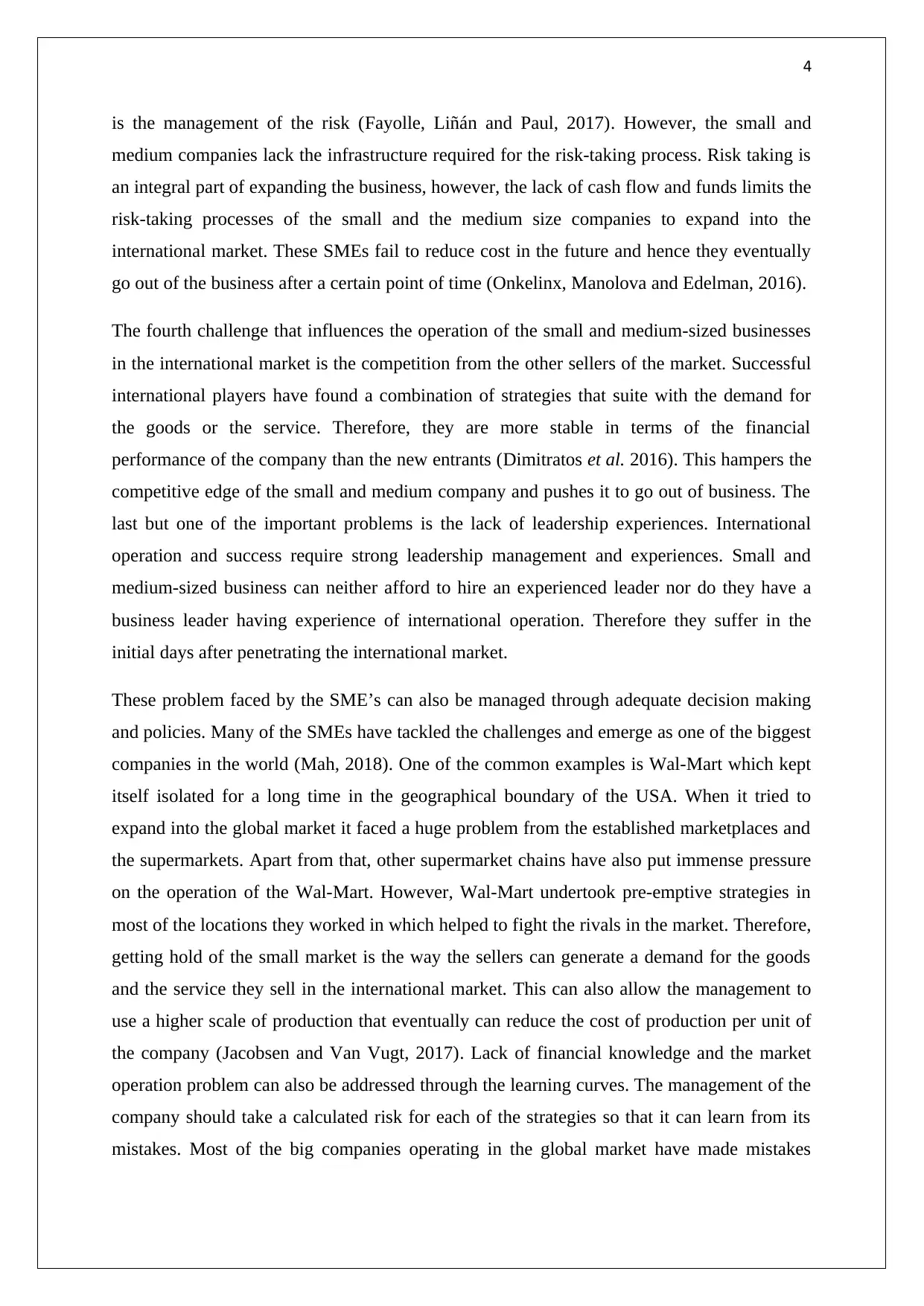
4
is the management of the risk (Fayolle, Liñán and Paul, 2017). However, the small and
medium companies lack the infrastructure required for the risk-taking process. Risk taking is
an integral part of expanding the business, however, the lack of cash flow and funds limits the
risk-taking processes of the small and the medium size companies to expand into the
international market. These SMEs fail to reduce cost in the future and hence they eventually
go out of the business after a certain point of time (Onkelinx, Manolova and Edelman, 2016).
The fourth challenge that influences the operation of the small and medium-sized businesses
in the international market is the competition from the other sellers of the market. Successful
international players have found a combination of strategies that suite with the demand for
the goods or the service. Therefore, they are more stable in terms of the financial
performance of the company than the new entrants (Dimitratos et al. 2016). This hampers the
competitive edge of the small and medium company and pushes it to go out of business. The
last but one of the important problems is the lack of leadership experiences. International
operation and success require strong leadership management and experiences. Small and
medium-sized business can neither afford to hire an experienced leader nor do they have a
business leader having experience of international operation. Therefore they suffer in the
initial days after penetrating the international market.
These problem faced by the SME’s can also be managed through adequate decision making
and policies. Many of the SMEs have tackled the challenges and emerge as one of the biggest
companies in the world (Mah, 2018). One of the common examples is Wal-Mart which kept
itself isolated for a long time in the geographical boundary of the USA. When it tried to
expand into the global market it faced a huge problem from the established marketplaces and
the supermarkets. Apart from that, other supermarket chains have also put immense pressure
on the operation of the Wal-Mart. However, Wal-Mart undertook pre-emptive strategies in
most of the locations they worked in which helped to fight the rivals in the market. Therefore,
getting hold of the small market is the way the sellers can generate a demand for the goods
and the service they sell in the international market. This can also allow the management to
use a higher scale of production that eventually can reduce the cost of production per unit of
the company (Jacobsen and Van Vugt, 2017). Lack of financial knowledge and the market
operation problem can also be addressed through the learning curves. The management of the
company should take a calculated risk for each of the strategies so that it can learn from its
mistakes. Most of the big companies operating in the global market have made mistakes
is the management of the risk (Fayolle, Liñán and Paul, 2017). However, the small and
medium companies lack the infrastructure required for the risk-taking process. Risk taking is
an integral part of expanding the business, however, the lack of cash flow and funds limits the
risk-taking processes of the small and the medium size companies to expand into the
international market. These SMEs fail to reduce cost in the future and hence they eventually
go out of the business after a certain point of time (Onkelinx, Manolova and Edelman, 2016).
The fourth challenge that influences the operation of the small and medium-sized businesses
in the international market is the competition from the other sellers of the market. Successful
international players have found a combination of strategies that suite with the demand for
the goods or the service. Therefore, they are more stable in terms of the financial
performance of the company than the new entrants (Dimitratos et al. 2016). This hampers the
competitive edge of the small and medium company and pushes it to go out of business. The
last but one of the important problems is the lack of leadership experiences. International
operation and success require strong leadership management and experiences. Small and
medium-sized business can neither afford to hire an experienced leader nor do they have a
business leader having experience of international operation. Therefore they suffer in the
initial days after penetrating the international market.
These problem faced by the SME’s can also be managed through adequate decision making
and policies. Many of the SMEs have tackled the challenges and emerge as one of the biggest
companies in the world (Mah, 2018). One of the common examples is Wal-Mart which kept
itself isolated for a long time in the geographical boundary of the USA. When it tried to
expand into the global market it faced a huge problem from the established marketplaces and
the supermarkets. Apart from that, other supermarket chains have also put immense pressure
on the operation of the Wal-Mart. However, Wal-Mart undertook pre-emptive strategies in
most of the locations they worked in which helped to fight the rivals in the market. Therefore,
getting hold of the small market is the way the sellers can generate a demand for the goods
and the service they sell in the international market. This can also allow the management to
use a higher scale of production that eventually can reduce the cost of production per unit of
the company (Jacobsen and Van Vugt, 2017). Lack of financial knowledge and the market
operation problem can also be addressed through the learning curves. The management of the
company should take a calculated risk for each of the strategies so that it can learn from its
mistakes. Most of the big companies operating in the global market have made mistakes
Paraphrase This Document
Need a fresh take? Get an instant paraphrase of this document with our AI Paraphraser
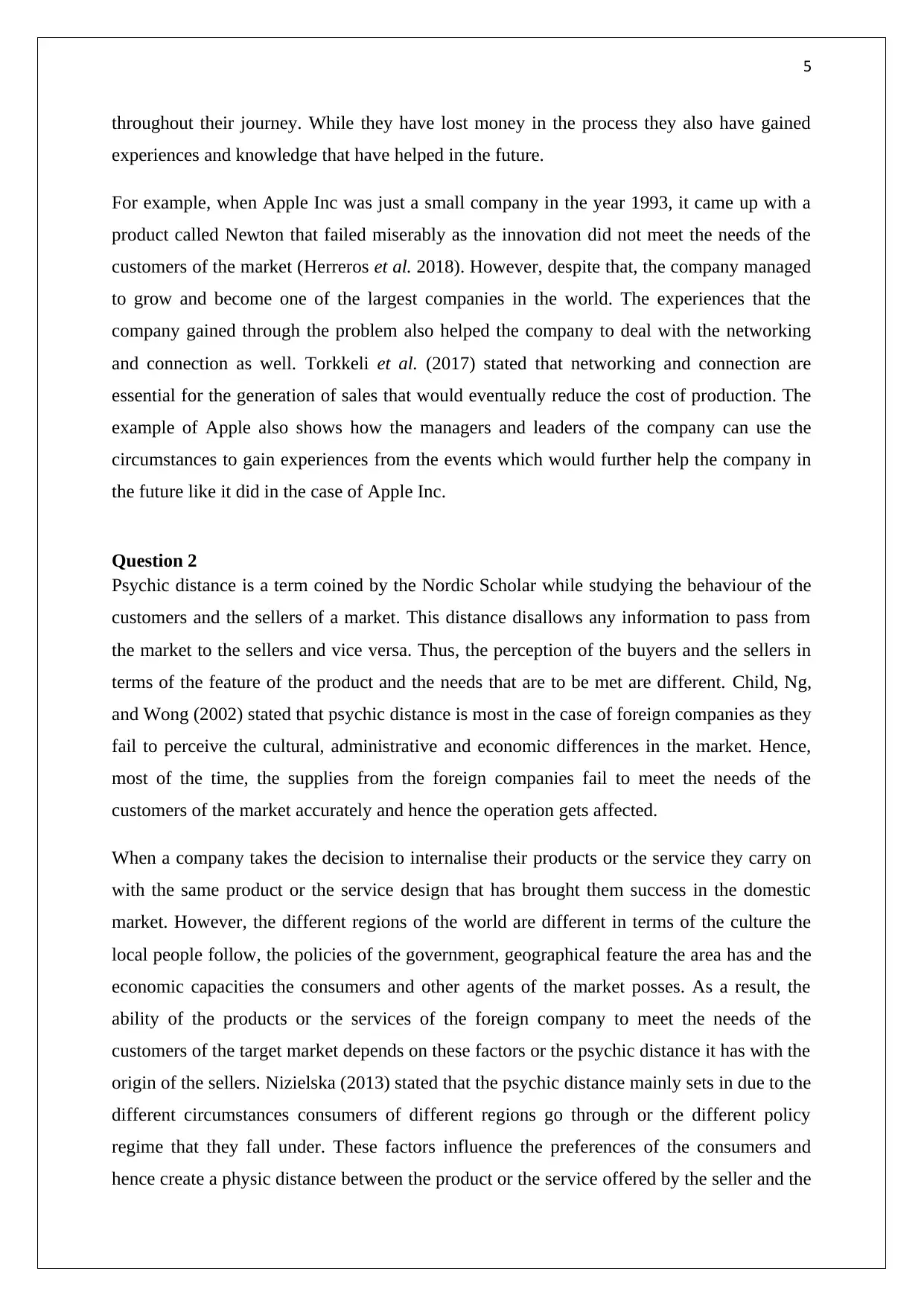
5
throughout their journey. While they have lost money in the process they also have gained
experiences and knowledge that have helped in the future.
For example, when Apple Inc was just a small company in the year 1993, it came up with a
product called Newton that failed miserably as the innovation did not meet the needs of the
customers of the market (Herreros et al. 2018). However, despite that, the company managed
to grow and become one of the largest companies in the world. The experiences that the
company gained through the problem also helped the company to deal with the networking
and connection as well. Torkkeli et al. (2017) stated that networking and connection are
essential for the generation of sales that would eventually reduce the cost of production. The
example of Apple also shows how the managers and leaders of the company can use the
circumstances to gain experiences from the events which would further help the company in
the future like it did in the case of Apple Inc.
Question 2
Psychic distance is a term coined by the Nordic Scholar while studying the behaviour of the
customers and the sellers of a market. This distance disallows any information to pass from
the market to the sellers and vice versa. Thus, the perception of the buyers and the sellers in
terms of the feature of the product and the needs that are to be met are different. Child, Ng,
and Wong (2002) stated that psychic distance is most in the case of foreign companies as they
fail to perceive the cultural, administrative and economic differences in the market. Hence,
most of the time, the supplies from the foreign companies fail to meet the needs of the
customers of the market accurately and hence the operation gets affected.
When a company takes the decision to internalise their products or the service they carry on
with the same product or the service design that has brought them success in the domestic
market. However, the different regions of the world are different in terms of the culture the
local people follow, the policies of the government, geographical feature the area has and the
economic capacities the consumers and other agents of the market posses. As a result, the
ability of the products or the services of the foreign company to meet the needs of the
customers of the target market depends on these factors or the psychic distance it has with the
origin of the sellers. Nizielska (2013) stated that the psychic distance mainly sets in due to the
different circumstances consumers of different regions go through or the different policy
regime that they fall under. These factors influence the preferences of the consumers and
hence create a physic distance between the product or the service offered by the seller and the
throughout their journey. While they have lost money in the process they also have gained
experiences and knowledge that have helped in the future.
For example, when Apple Inc was just a small company in the year 1993, it came up with a
product called Newton that failed miserably as the innovation did not meet the needs of the
customers of the market (Herreros et al. 2018). However, despite that, the company managed
to grow and become one of the largest companies in the world. The experiences that the
company gained through the problem also helped the company to deal with the networking
and connection as well. Torkkeli et al. (2017) stated that networking and connection are
essential for the generation of sales that would eventually reduce the cost of production. The
example of Apple also shows how the managers and leaders of the company can use the
circumstances to gain experiences from the events which would further help the company in
the future like it did in the case of Apple Inc.
Question 2
Psychic distance is a term coined by the Nordic Scholar while studying the behaviour of the
customers and the sellers of a market. This distance disallows any information to pass from
the market to the sellers and vice versa. Thus, the perception of the buyers and the sellers in
terms of the feature of the product and the needs that are to be met are different. Child, Ng,
and Wong (2002) stated that psychic distance is most in the case of foreign companies as they
fail to perceive the cultural, administrative and economic differences in the market. Hence,
most of the time, the supplies from the foreign companies fail to meet the needs of the
customers of the market accurately and hence the operation gets affected.
When a company takes the decision to internalise their products or the service they carry on
with the same product or the service design that has brought them success in the domestic
market. However, the different regions of the world are different in terms of the culture the
local people follow, the policies of the government, geographical feature the area has and the
economic capacities the consumers and other agents of the market posses. As a result, the
ability of the products or the services of the foreign company to meet the needs of the
customers of the target market depends on these factors or the psychic distance it has with the
origin of the sellers. Nizielska (2013) stated that the psychic distance mainly sets in due to the
different circumstances consumers of different regions go through or the different policy
regime that they fall under. These factors influence the preferences of the consumers and
hence create a physic distance between the product or the service offered by the seller and the
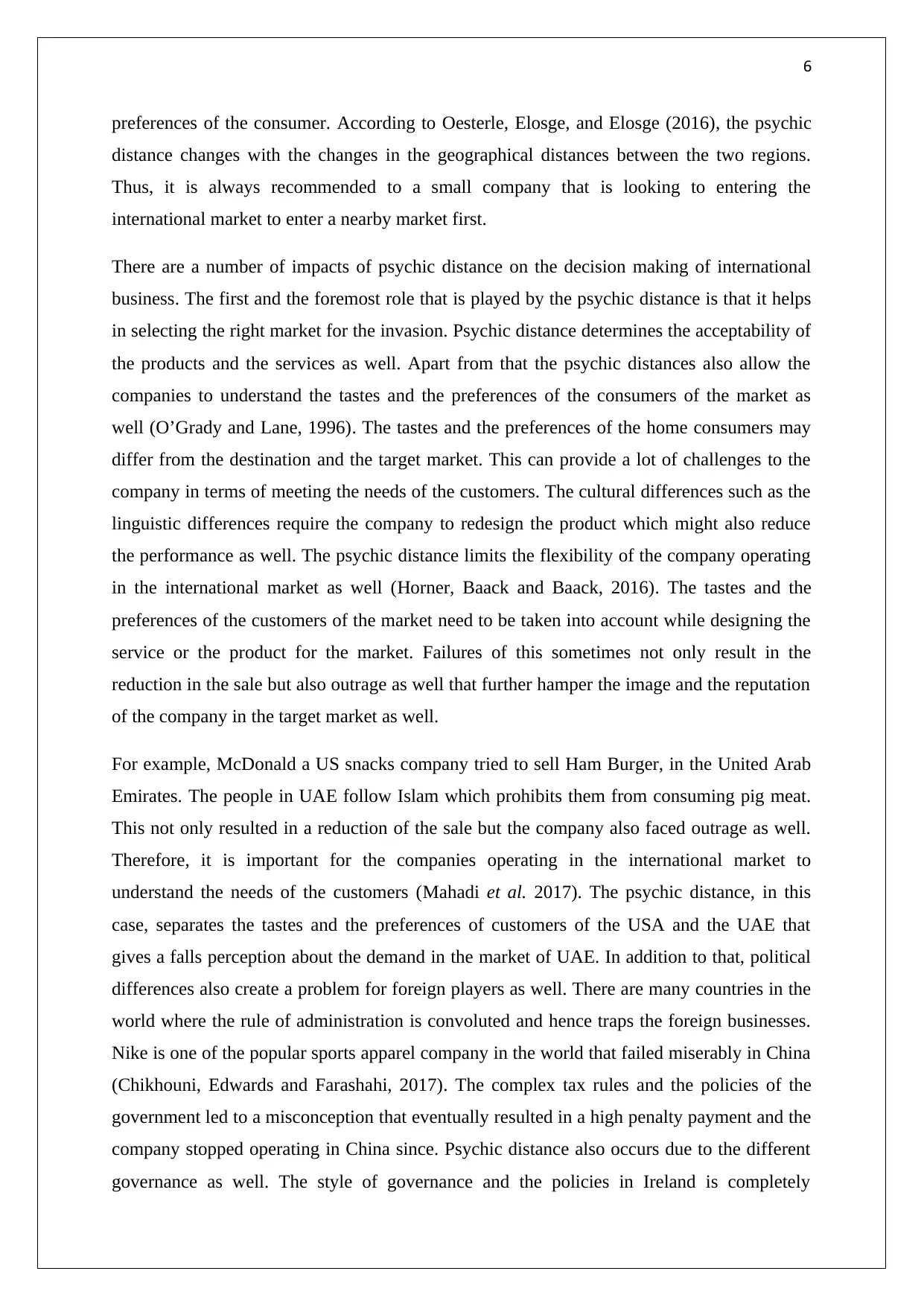
6
preferences of the consumer. According to Oesterle, Elosge, and Elosge (2016), the psychic
distance changes with the changes in the geographical distances between the two regions.
Thus, it is always recommended to a small company that is looking to entering the
international market to enter a nearby market first.
There are a number of impacts of psychic distance on the decision making of international
business. The first and the foremost role that is played by the psychic distance is that it helps
in selecting the right market for the invasion. Psychic distance determines the acceptability of
the products and the services as well. Apart from that the psychic distances also allow the
companies to understand the tastes and the preferences of the consumers of the market as
well (O’Grady and Lane, 1996). The tastes and the preferences of the home consumers may
differ from the destination and the target market. This can provide a lot of challenges to the
company in terms of meeting the needs of the customers. The cultural differences such as the
linguistic differences require the company to redesign the product which might also reduce
the performance as well. The psychic distance limits the flexibility of the company operating
in the international market as well (Horner, Baack and Baack, 2016). The tastes and the
preferences of the customers of the market need to be taken into account while designing the
service or the product for the market. Failures of this sometimes not only result in the
reduction in the sale but also outrage as well that further hamper the image and the reputation
of the company in the target market as well.
For example, McDonald a US snacks company tried to sell Ham Burger, in the United Arab
Emirates. The people in UAE follow Islam which prohibits them from consuming pig meat.
This not only resulted in a reduction of the sale but the company also faced outrage as well.
Therefore, it is important for the companies operating in the international market to
understand the needs of the customers (Mahadi et al. 2017). The psychic distance, in this
case, separates the tastes and the preferences of customers of the USA and the UAE that
gives a falls perception about the demand in the market of UAE. In addition to that, political
differences also create a problem for foreign players as well. There are many countries in the
world where the rule of administration is convoluted and hence traps the foreign businesses.
Nike is one of the popular sports apparel company in the world that failed miserably in China
(Chikhouni, Edwards and Farashahi, 2017). The complex tax rules and the policies of the
government led to a misconception that eventually resulted in a high penalty payment and the
company stopped operating in China since. Psychic distance also occurs due to the different
governance as well. The style of governance and the policies in Ireland is completely
preferences of the consumer. According to Oesterle, Elosge, and Elosge (2016), the psychic
distance changes with the changes in the geographical distances between the two regions.
Thus, it is always recommended to a small company that is looking to entering the
international market to enter a nearby market first.
There are a number of impacts of psychic distance on the decision making of international
business. The first and the foremost role that is played by the psychic distance is that it helps
in selecting the right market for the invasion. Psychic distance determines the acceptability of
the products and the services as well. Apart from that the psychic distances also allow the
companies to understand the tastes and the preferences of the consumers of the market as
well (O’Grady and Lane, 1996). The tastes and the preferences of the home consumers may
differ from the destination and the target market. This can provide a lot of challenges to the
company in terms of meeting the needs of the customers. The cultural differences such as the
linguistic differences require the company to redesign the product which might also reduce
the performance as well. The psychic distance limits the flexibility of the company operating
in the international market as well (Horner, Baack and Baack, 2016). The tastes and the
preferences of the customers of the market need to be taken into account while designing the
service or the product for the market. Failures of this sometimes not only result in the
reduction in the sale but also outrage as well that further hamper the image and the reputation
of the company in the target market as well.
For example, McDonald a US snacks company tried to sell Ham Burger, in the United Arab
Emirates. The people in UAE follow Islam which prohibits them from consuming pig meat.
This not only resulted in a reduction of the sale but the company also faced outrage as well.
Therefore, it is important for the companies operating in the international market to
understand the needs of the customers (Mahadi et al. 2017). The psychic distance, in this
case, separates the tastes and the preferences of customers of the USA and the UAE that
gives a falls perception about the demand in the market of UAE. In addition to that, political
differences also create a problem for foreign players as well. There are many countries in the
world where the rule of administration is convoluted and hence traps the foreign businesses.
Nike is one of the popular sports apparel company in the world that failed miserably in China
(Chikhouni, Edwards and Farashahi, 2017). The complex tax rules and the policies of the
government led to a misconception that eventually resulted in a high penalty payment and the
company stopped operating in China since. Psychic distance also occurs due to the different
governance as well. The style of governance and the policies in Ireland is completely
⊘ This is a preview!⊘
Do you want full access?
Subscribe today to unlock all pages.

Trusted by 1+ million students worldwide
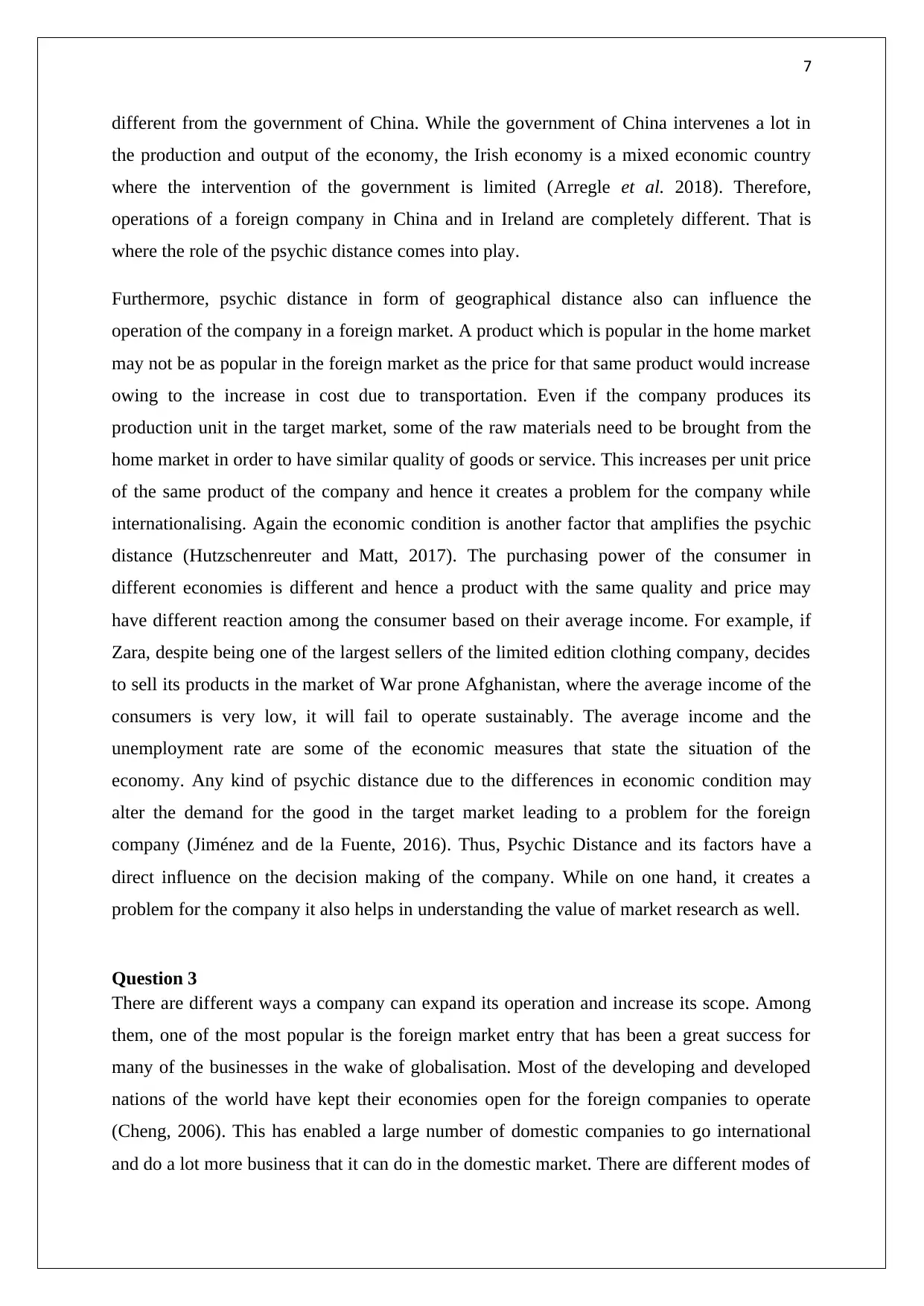
7
different from the government of China. While the government of China intervenes a lot in
the production and output of the economy, the Irish economy is a mixed economic country
where the intervention of the government is limited (Arregle et al. 2018). Therefore,
operations of a foreign company in China and in Ireland are completely different. That is
where the role of the psychic distance comes into play.
Furthermore, psychic distance in form of geographical distance also can influence the
operation of the company in a foreign market. A product which is popular in the home market
may not be as popular in the foreign market as the price for that same product would increase
owing to the increase in cost due to transportation. Even if the company produces its
production unit in the target market, some of the raw materials need to be brought from the
home market in order to have similar quality of goods or service. This increases per unit price
of the same product of the company and hence it creates a problem for the company while
internationalising. Again the economic condition is another factor that amplifies the psychic
distance (Hutzschenreuter and Matt, 2017). The purchasing power of the consumer in
different economies is different and hence a product with the same quality and price may
have different reaction among the consumer based on their average income. For example, if
Zara, despite being one of the largest sellers of the limited edition clothing company, decides
to sell its products in the market of War prone Afghanistan, where the average income of the
consumers is very low, it will fail to operate sustainably. The average income and the
unemployment rate are some of the economic measures that state the situation of the
economy. Any kind of psychic distance due to the differences in economic condition may
alter the demand for the good in the target market leading to a problem for the foreign
company (Jiménez and de la Fuente, 2016). Thus, Psychic Distance and its factors have a
direct influence on the decision making of the company. While on one hand, it creates a
problem for the company it also helps in understanding the value of market research as well.
Question 3
There are different ways a company can expand its operation and increase its scope. Among
them, one of the most popular is the foreign market entry that has been a great success for
many of the businesses in the wake of globalisation. Most of the developing and developed
nations of the world have kept their economies open for the foreign companies to operate
(Cheng, 2006). This has enabled a large number of domestic companies to go international
and do a lot more business that it can do in the domestic market. There are different modes of
different from the government of China. While the government of China intervenes a lot in
the production and output of the economy, the Irish economy is a mixed economic country
where the intervention of the government is limited (Arregle et al. 2018). Therefore,
operations of a foreign company in China and in Ireland are completely different. That is
where the role of the psychic distance comes into play.
Furthermore, psychic distance in form of geographical distance also can influence the
operation of the company in a foreign market. A product which is popular in the home market
may not be as popular in the foreign market as the price for that same product would increase
owing to the increase in cost due to transportation. Even if the company produces its
production unit in the target market, some of the raw materials need to be brought from the
home market in order to have similar quality of goods or service. This increases per unit price
of the same product of the company and hence it creates a problem for the company while
internationalising. Again the economic condition is another factor that amplifies the psychic
distance (Hutzschenreuter and Matt, 2017). The purchasing power of the consumer in
different economies is different and hence a product with the same quality and price may
have different reaction among the consumer based on their average income. For example, if
Zara, despite being one of the largest sellers of the limited edition clothing company, decides
to sell its products in the market of War prone Afghanistan, where the average income of the
consumers is very low, it will fail to operate sustainably. The average income and the
unemployment rate are some of the economic measures that state the situation of the
economy. Any kind of psychic distance due to the differences in economic condition may
alter the demand for the good in the target market leading to a problem for the foreign
company (Jiménez and de la Fuente, 2016). Thus, Psychic Distance and its factors have a
direct influence on the decision making of the company. While on one hand, it creates a
problem for the company it also helps in understanding the value of market research as well.
Question 3
There are different ways a company can expand its operation and increase its scope. Among
them, one of the most popular is the foreign market entry that has been a great success for
many of the businesses in the wake of globalisation. Most of the developing and developed
nations of the world have kept their economies open for the foreign companies to operate
(Cheng, 2006). This has enabled a large number of domestic companies to go international
and do a lot more business that it can do in the domestic market. There are different modes of
Paraphrase This Document
Need a fresh take? Get an instant paraphrase of this document with our AI Paraphraser
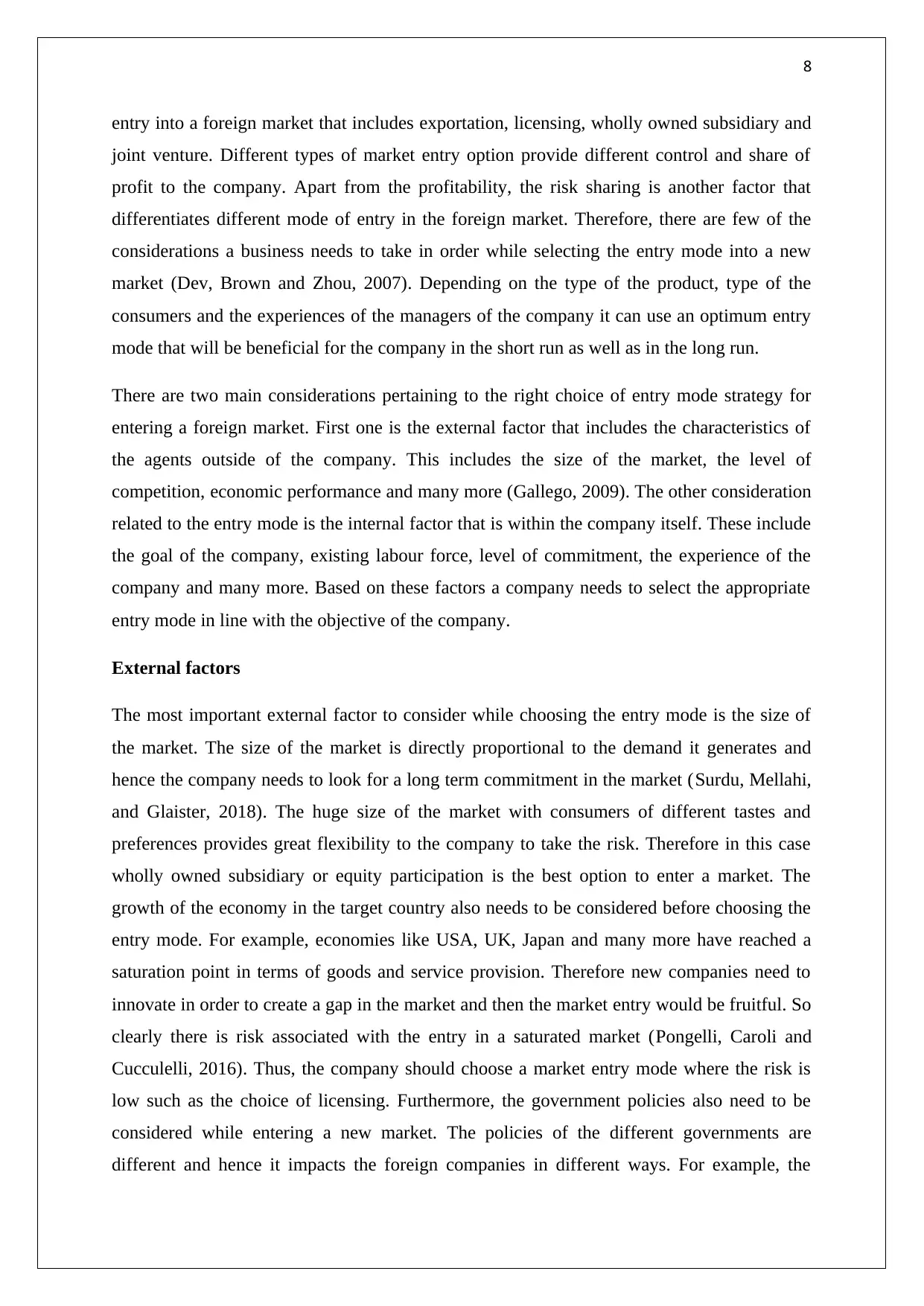
8
entry into a foreign market that includes exportation, licensing, wholly owned subsidiary and
joint venture. Different types of market entry option provide different control and share of
profit to the company. Apart from the profitability, the risk sharing is another factor that
differentiates different mode of entry in the foreign market. Therefore, there are few of the
considerations a business needs to take in order while selecting the entry mode into a new
market (Dev, Brown and Zhou, 2007). Depending on the type of the product, type of the
consumers and the experiences of the managers of the company it can use an optimum entry
mode that will be beneficial for the company in the short run as well as in the long run.
There are two main considerations pertaining to the right choice of entry mode strategy for
entering a foreign market. First one is the external factor that includes the characteristics of
the agents outside of the company. This includes the size of the market, the level of
competition, economic performance and many more (Gallego, 2009). The other consideration
related to the entry mode is the internal factor that is within the company itself. These include
the goal of the company, existing labour force, level of commitment, the experience of the
company and many more. Based on these factors a company needs to select the appropriate
entry mode in line with the objective of the company.
External factors
The most important external factor to consider while choosing the entry mode is the size of
the market. The size of the market is directly proportional to the demand it generates and
hence the company needs to look for a long term commitment in the market (Surdu, Mellahi,
and Glaister, 2018). The huge size of the market with consumers of different tastes and
preferences provides great flexibility to the company to take the risk. Therefore in this case
wholly owned subsidiary or equity participation is the best option to enter a market. The
growth of the economy in the target country also needs to be considered before choosing the
entry mode. For example, economies like USA, UK, Japan and many more have reached a
saturation point in terms of goods and service provision. Therefore new companies need to
innovate in order to create a gap in the market and then the market entry would be fruitful. So
clearly there is risk associated with the entry in a saturated market (Pongelli, Caroli and
Cucculelli, 2016). Thus, the company should choose a market entry mode where the risk is
low such as the choice of licensing. Furthermore, the government policies also need to be
considered while entering a new market. The policies of the different governments are
different and hence it impacts the foreign companies in different ways. For example, the
entry into a foreign market that includes exportation, licensing, wholly owned subsidiary and
joint venture. Different types of market entry option provide different control and share of
profit to the company. Apart from the profitability, the risk sharing is another factor that
differentiates different mode of entry in the foreign market. Therefore, there are few of the
considerations a business needs to take in order while selecting the entry mode into a new
market (Dev, Brown and Zhou, 2007). Depending on the type of the product, type of the
consumers and the experiences of the managers of the company it can use an optimum entry
mode that will be beneficial for the company in the short run as well as in the long run.
There are two main considerations pertaining to the right choice of entry mode strategy for
entering a foreign market. First one is the external factor that includes the characteristics of
the agents outside of the company. This includes the size of the market, the level of
competition, economic performance and many more (Gallego, 2009). The other consideration
related to the entry mode is the internal factor that is within the company itself. These include
the goal of the company, existing labour force, level of commitment, the experience of the
company and many more. Based on these factors a company needs to select the appropriate
entry mode in line with the objective of the company.
External factors
The most important external factor to consider while choosing the entry mode is the size of
the market. The size of the market is directly proportional to the demand it generates and
hence the company needs to look for a long term commitment in the market (Surdu, Mellahi,
and Glaister, 2018). The huge size of the market with consumers of different tastes and
preferences provides great flexibility to the company to take the risk. Therefore in this case
wholly owned subsidiary or equity participation is the best option to enter a market. The
growth of the economy in the target country also needs to be considered before choosing the
entry mode. For example, economies like USA, UK, Japan and many more have reached a
saturation point in terms of goods and service provision. Therefore new companies need to
innovate in order to create a gap in the market and then the market entry would be fruitful. So
clearly there is risk associated with the entry in a saturated market (Pongelli, Caroli and
Cucculelli, 2016). Thus, the company should choose a market entry mode where the risk is
low such as the choice of licensing. Furthermore, the government policies also need to be
considered while entering a new market. The policies of the different governments are
different and hence it impacts the foreign companies in different ways. For example, the
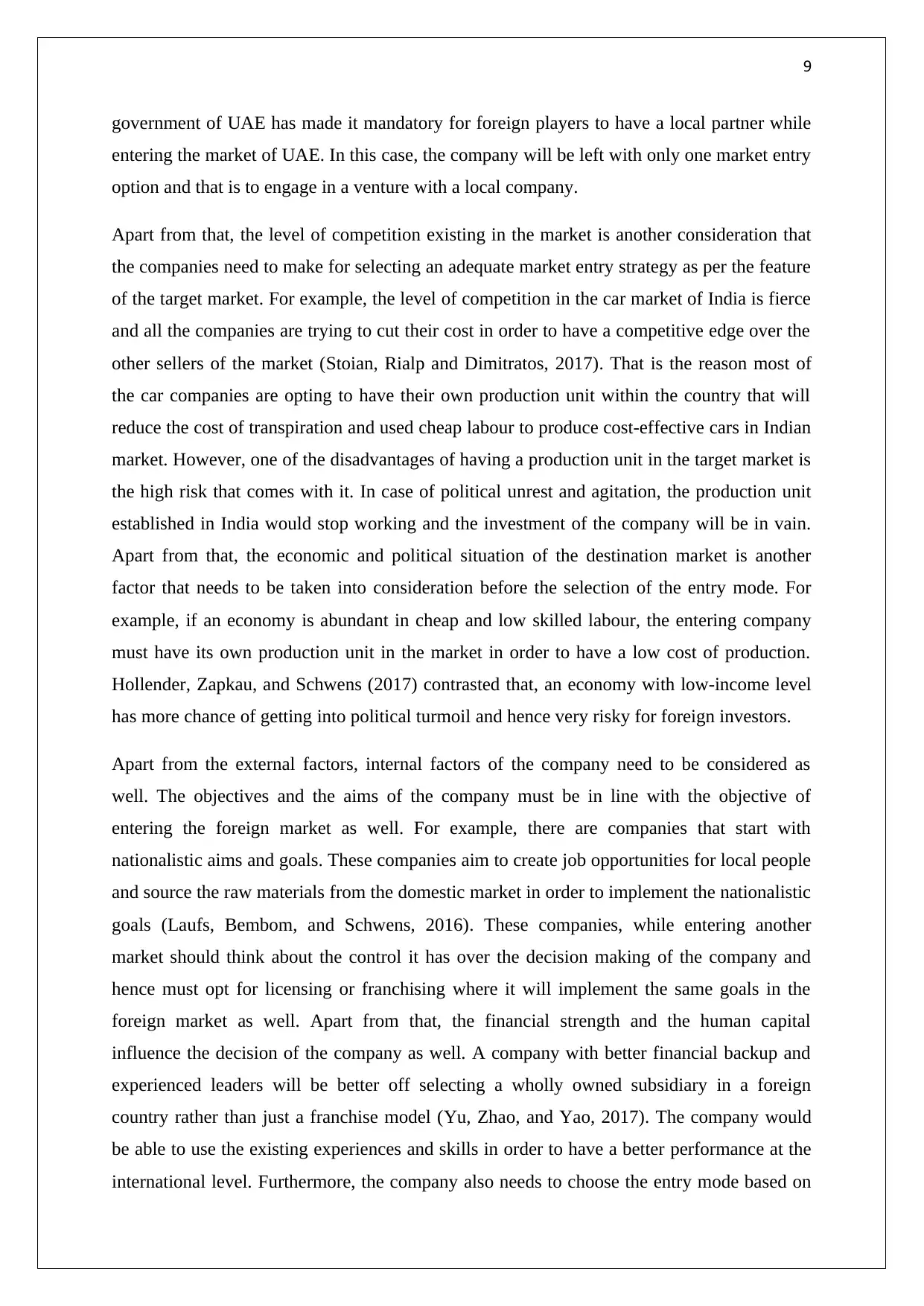
9
government of UAE has made it mandatory for foreign players to have a local partner while
entering the market of UAE. In this case, the company will be left with only one market entry
option and that is to engage in a venture with a local company.
Apart from that, the level of competition existing in the market is another consideration that
the companies need to make for selecting an adequate market entry strategy as per the feature
of the target market. For example, the level of competition in the car market of India is fierce
and all the companies are trying to cut their cost in order to have a competitive edge over the
other sellers of the market (Stoian, Rialp and Dimitratos, 2017). That is the reason most of
the car companies are opting to have their own production unit within the country that will
reduce the cost of transpiration and used cheap labour to produce cost-effective cars in Indian
market. However, one of the disadvantages of having a production unit in the target market is
the high risk that comes with it. In case of political unrest and agitation, the production unit
established in India would stop working and the investment of the company will be in vain.
Apart from that, the economic and political situation of the destination market is another
factor that needs to be taken into consideration before the selection of the entry mode. For
example, if an economy is abundant in cheap and low skilled labour, the entering company
must have its own production unit in the market in order to have a low cost of production.
Hollender, Zapkau, and Schwens (2017) contrasted that, an economy with low-income level
has more chance of getting into political turmoil and hence very risky for foreign investors.
Apart from the external factors, internal factors of the company need to be considered as
well. The objectives and the aims of the company must be in line with the objective of
entering the foreign market as well. For example, there are companies that start with
nationalistic aims and goals. These companies aim to create job opportunities for local people
and source the raw materials from the domestic market in order to implement the nationalistic
goals (Laufs, Bembom, and Schwens, 2016). These companies, while entering another
market should think about the control it has over the decision making of the company and
hence must opt for licensing or franchising where it will implement the same goals in the
foreign market as well. Apart from that, the financial strength and the human capital
influence the decision of the company as well. A company with better financial backup and
experienced leaders will be better off selecting a wholly owned subsidiary in a foreign
country rather than just a franchise model (Yu, Zhao, and Yao, 2017). The company would
be able to use the existing experiences and skills in order to have a better performance at the
international level. Furthermore, the company also needs to choose the entry mode based on
government of UAE has made it mandatory for foreign players to have a local partner while
entering the market of UAE. In this case, the company will be left with only one market entry
option and that is to engage in a venture with a local company.
Apart from that, the level of competition existing in the market is another consideration that
the companies need to make for selecting an adequate market entry strategy as per the feature
of the target market. For example, the level of competition in the car market of India is fierce
and all the companies are trying to cut their cost in order to have a competitive edge over the
other sellers of the market (Stoian, Rialp and Dimitratos, 2017). That is the reason most of
the car companies are opting to have their own production unit within the country that will
reduce the cost of transpiration and used cheap labour to produce cost-effective cars in Indian
market. However, one of the disadvantages of having a production unit in the target market is
the high risk that comes with it. In case of political unrest and agitation, the production unit
established in India would stop working and the investment of the company will be in vain.
Apart from that, the economic and political situation of the destination market is another
factor that needs to be taken into consideration before the selection of the entry mode. For
example, if an economy is abundant in cheap and low skilled labour, the entering company
must have its own production unit in the market in order to have a low cost of production.
Hollender, Zapkau, and Schwens (2017) contrasted that, an economy with low-income level
has more chance of getting into political turmoil and hence very risky for foreign investors.
Apart from the external factors, internal factors of the company need to be considered as
well. The objectives and the aims of the company must be in line with the objective of
entering the foreign market as well. For example, there are companies that start with
nationalistic aims and goals. These companies aim to create job opportunities for local people
and source the raw materials from the domestic market in order to implement the nationalistic
goals (Laufs, Bembom, and Schwens, 2016). These companies, while entering another
market should think about the control it has over the decision making of the company and
hence must opt for licensing or franchising where it will implement the same goals in the
foreign market as well. Apart from that, the financial strength and the human capital
influence the decision of the company as well. A company with better financial backup and
experienced leaders will be better off selecting a wholly owned subsidiary in a foreign
country rather than just a franchise model (Yu, Zhao, and Yao, 2017). The company would
be able to use the existing experiences and skills in order to have a better performance at the
international level. Furthermore, the company also needs to choose the entry mode based on
⊘ This is a preview!⊘
Do you want full access?
Subscribe today to unlock all pages.

Trusted by 1+ million students worldwide
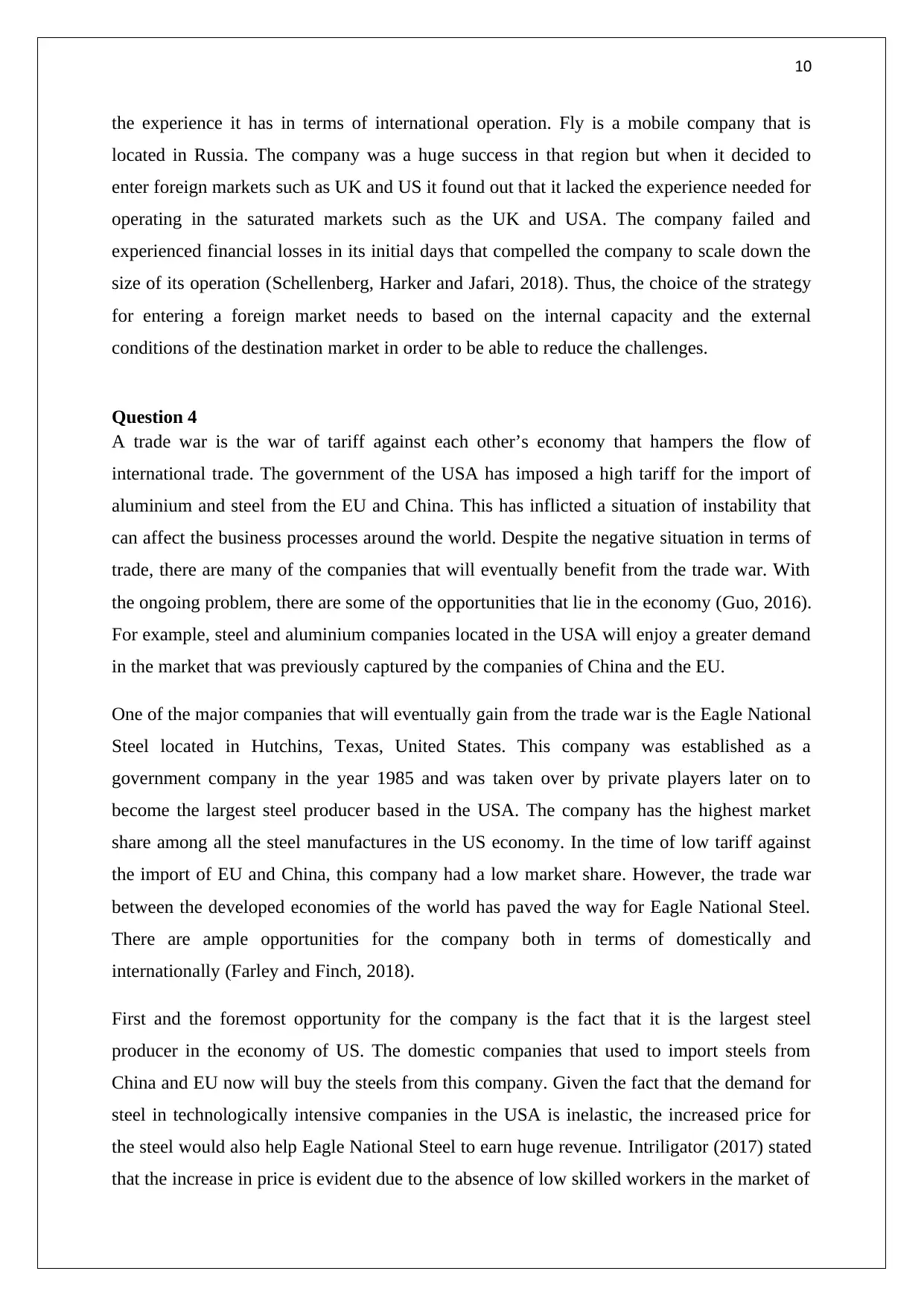
10
the experience it has in terms of international operation. Fly is a mobile company that is
located in Russia. The company was a huge success in that region but when it decided to
enter foreign markets such as UK and US it found out that it lacked the experience needed for
operating in the saturated markets such as the UK and USA. The company failed and
experienced financial losses in its initial days that compelled the company to scale down the
size of its operation (Schellenberg, Harker and Jafari, 2018). Thus, the choice of the strategy
for entering a foreign market needs to based on the internal capacity and the external
conditions of the destination market in order to be able to reduce the challenges.
Question 4
A trade war is the war of tariff against each other’s economy that hampers the flow of
international trade. The government of the USA has imposed a high tariff for the import of
aluminium and steel from the EU and China. This has inflicted a situation of instability that
can affect the business processes around the world. Despite the negative situation in terms of
trade, there are many of the companies that will eventually benefit from the trade war. With
the ongoing problem, there are some of the opportunities that lie in the economy (Guo, 2016).
For example, steel and aluminium companies located in the USA will enjoy a greater demand
in the market that was previously captured by the companies of China and the EU.
One of the major companies that will eventually gain from the trade war is the Eagle National
Steel located in Hutchins, Texas, United States. This company was established as a
government company in the year 1985 and was taken over by private players later on to
become the largest steel producer based in the USA. The company has the highest market
share among all the steel manufactures in the US economy. In the time of low tariff against
the import of EU and China, this company had a low market share. However, the trade war
between the developed economies of the world has paved the way for Eagle National Steel.
There are ample opportunities for the company both in terms of domestically and
internationally (Farley and Finch, 2018).
First and the foremost opportunity for the company is the fact that it is the largest steel
producer in the economy of US. The domestic companies that used to import steels from
China and EU now will buy the steels from this company. Given the fact that the demand for
steel in technologically intensive companies in the USA is inelastic, the increased price for
the steel would also help Eagle National Steel to earn huge revenue. Intriligator (2017) stated
that the increase in price is evident due to the absence of low skilled workers in the market of
the experience it has in terms of international operation. Fly is a mobile company that is
located in Russia. The company was a huge success in that region but when it decided to
enter foreign markets such as UK and US it found out that it lacked the experience needed for
operating in the saturated markets such as the UK and USA. The company failed and
experienced financial losses in its initial days that compelled the company to scale down the
size of its operation (Schellenberg, Harker and Jafari, 2018). Thus, the choice of the strategy
for entering a foreign market needs to based on the internal capacity and the external
conditions of the destination market in order to be able to reduce the challenges.
Question 4
A trade war is the war of tariff against each other’s economy that hampers the flow of
international trade. The government of the USA has imposed a high tariff for the import of
aluminium and steel from the EU and China. This has inflicted a situation of instability that
can affect the business processes around the world. Despite the negative situation in terms of
trade, there are many of the companies that will eventually benefit from the trade war. With
the ongoing problem, there are some of the opportunities that lie in the economy (Guo, 2016).
For example, steel and aluminium companies located in the USA will enjoy a greater demand
in the market that was previously captured by the companies of China and the EU.
One of the major companies that will eventually gain from the trade war is the Eagle National
Steel located in Hutchins, Texas, United States. This company was established as a
government company in the year 1985 and was taken over by private players later on to
become the largest steel producer based in the USA. The company has the highest market
share among all the steel manufactures in the US economy. In the time of low tariff against
the import of EU and China, this company had a low market share. However, the trade war
between the developed economies of the world has paved the way for Eagle National Steel.
There are ample opportunities for the company both in terms of domestically and
internationally (Farley and Finch, 2018).
First and the foremost opportunity for the company is the fact that it is the largest steel
producer in the economy of US. The domestic companies that used to import steels from
China and EU now will buy the steels from this company. Given the fact that the demand for
steel in technologically intensive companies in the USA is inelastic, the increased price for
the steel would also help Eagle National Steel to earn huge revenue. Intriligator (2017) stated
that the increase in price is evident due to the absence of low skilled workers in the market of
Paraphrase This Document
Need a fresh take? Get an instant paraphrase of this document with our AI Paraphraser
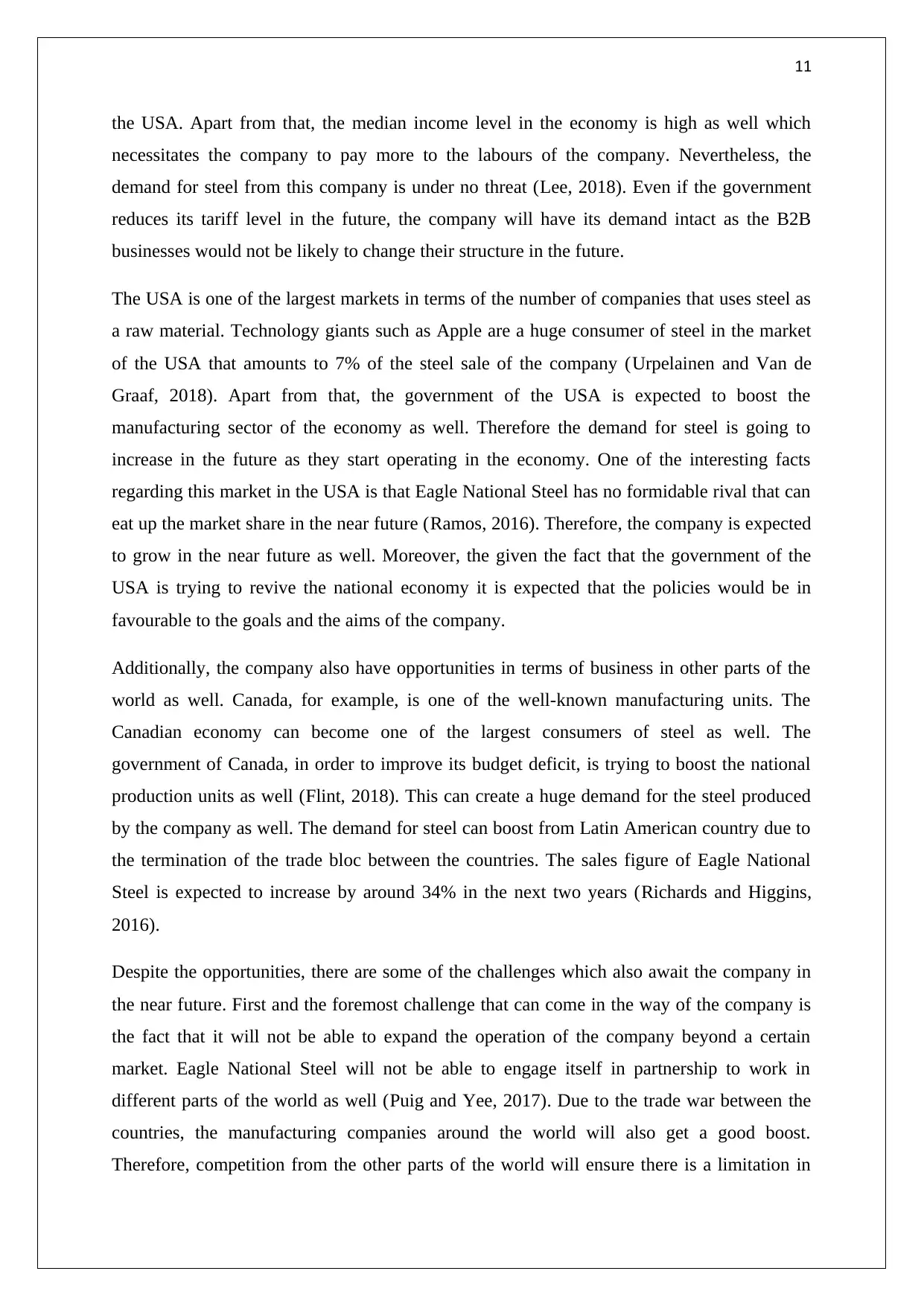
11
the USA. Apart from that, the median income level in the economy is high as well which
necessitates the company to pay more to the labours of the company. Nevertheless, the
demand for steel from this company is under no threat (Lee, 2018). Even if the government
reduces its tariff level in the future, the company will have its demand intact as the B2B
businesses would not be likely to change their structure in the future.
The USA is one of the largest markets in terms of the number of companies that uses steel as
a raw material. Technology giants such as Apple are a huge consumer of steel in the market
of the USA that amounts to 7% of the steel sale of the company (Urpelainen and Van de
Graaf, 2018). Apart from that, the government of the USA is expected to boost the
manufacturing sector of the economy as well. Therefore the demand for steel is going to
increase in the future as they start operating in the economy. One of the interesting facts
regarding this market in the USA is that Eagle National Steel has no formidable rival that can
eat up the market share in the near future (Ramos, 2016). Therefore, the company is expected
to grow in the near future as well. Moreover, the given the fact that the government of the
USA is trying to revive the national economy it is expected that the policies would be in
favourable to the goals and the aims of the company.
Additionally, the company also have opportunities in terms of business in other parts of the
world as well. Canada, for example, is one of the well-known manufacturing units. The
Canadian economy can become one of the largest consumers of steel as well. The
government of Canada, in order to improve its budget deficit, is trying to boost the national
production units as well (Flint, 2018). This can create a huge demand for the steel produced
by the company as well. The demand for steel can boost from Latin American country due to
the termination of the trade bloc between the countries. The sales figure of Eagle National
Steel is expected to increase by around 34% in the next two years (Richards and Higgins,
2016).
Despite the opportunities, there are some of the challenges which also await the company in
the near future. First and the foremost challenge that can come in the way of the company is
the fact that it will not be able to expand the operation of the company beyond a certain
market. Eagle National Steel will not be able to engage itself in partnership to work in
different parts of the world as well (Puig and Yee, 2017). Due to the trade war between the
countries, the manufacturing companies around the world will also get a good boost.
Therefore, competition from the other parts of the world will ensure there is a limitation in
the USA. Apart from that, the median income level in the economy is high as well which
necessitates the company to pay more to the labours of the company. Nevertheless, the
demand for steel from this company is under no threat (Lee, 2018). Even if the government
reduces its tariff level in the future, the company will have its demand intact as the B2B
businesses would not be likely to change their structure in the future.
The USA is one of the largest markets in terms of the number of companies that uses steel as
a raw material. Technology giants such as Apple are a huge consumer of steel in the market
of the USA that amounts to 7% of the steel sale of the company (Urpelainen and Van de
Graaf, 2018). Apart from that, the government of the USA is expected to boost the
manufacturing sector of the economy as well. Therefore the demand for steel is going to
increase in the future as they start operating in the economy. One of the interesting facts
regarding this market in the USA is that Eagle National Steel has no formidable rival that can
eat up the market share in the near future (Ramos, 2016). Therefore, the company is expected
to grow in the near future as well. Moreover, the given the fact that the government of the
USA is trying to revive the national economy it is expected that the policies would be in
favourable to the goals and the aims of the company.
Additionally, the company also have opportunities in terms of business in other parts of the
world as well. Canada, for example, is one of the well-known manufacturing units. The
Canadian economy can become one of the largest consumers of steel as well. The
government of Canada, in order to improve its budget deficit, is trying to boost the national
production units as well (Flint, 2018). This can create a huge demand for the steel produced
by the company as well. The demand for steel can boost from Latin American country due to
the termination of the trade bloc between the countries. The sales figure of Eagle National
Steel is expected to increase by around 34% in the next two years (Richards and Higgins,
2016).
Despite the opportunities, there are some of the challenges which also await the company in
the near future. First and the foremost challenge that can come in the way of the company is
the fact that it will not be able to expand the operation of the company beyond a certain
market. Eagle National Steel will not be able to engage itself in partnership to work in
different parts of the world as well (Puig and Yee, 2017). Due to the trade war between the
countries, the manufacturing companies around the world will also get a good boost.
Therefore, competition from the other parts of the world will ensure there is a limitation in
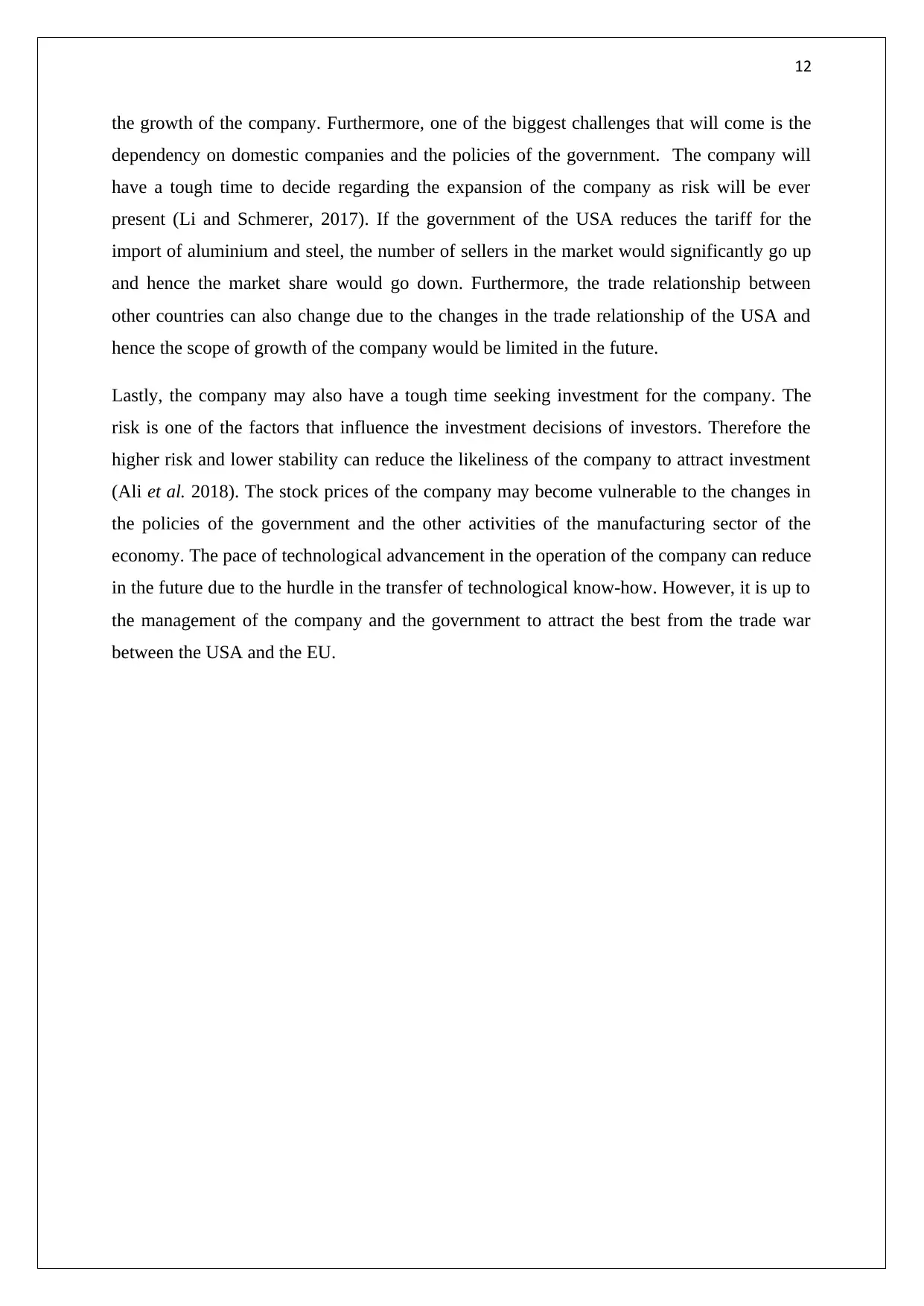
12
the growth of the company. Furthermore, one of the biggest challenges that will come is the
dependency on domestic companies and the policies of the government. The company will
have a tough time to decide regarding the expansion of the company as risk will be ever
present (Li and Schmerer, 2017). If the government of the USA reduces the tariff for the
import of aluminium and steel, the number of sellers in the market would significantly go up
and hence the market share would go down. Furthermore, the trade relationship between
other countries can also change due to the changes in the trade relationship of the USA and
hence the scope of growth of the company would be limited in the future.
Lastly, the company may also have a tough time seeking investment for the company. The
risk is one of the factors that influence the investment decisions of investors. Therefore the
higher risk and lower stability can reduce the likeliness of the company to attract investment
(Ali et al. 2018). The stock prices of the company may become vulnerable to the changes in
the policies of the government and the other activities of the manufacturing sector of the
economy. The pace of technological advancement in the operation of the company can reduce
in the future due to the hurdle in the transfer of technological know-how. However, it is up to
the management of the company and the government to attract the best from the trade war
between the USA and the EU.
the growth of the company. Furthermore, one of the biggest challenges that will come is the
dependency on domestic companies and the policies of the government. The company will
have a tough time to decide regarding the expansion of the company as risk will be ever
present (Li and Schmerer, 2017). If the government of the USA reduces the tariff for the
import of aluminium and steel, the number of sellers in the market would significantly go up
and hence the market share would go down. Furthermore, the trade relationship between
other countries can also change due to the changes in the trade relationship of the USA and
hence the scope of growth of the company would be limited in the future.
Lastly, the company may also have a tough time seeking investment for the company. The
risk is one of the factors that influence the investment decisions of investors. Therefore the
higher risk and lower stability can reduce the likeliness of the company to attract investment
(Ali et al. 2018). The stock prices of the company may become vulnerable to the changes in
the policies of the government and the other activities of the manufacturing sector of the
economy. The pace of technological advancement in the operation of the company can reduce
in the future due to the hurdle in the transfer of technological know-how. However, it is up to
the management of the company and the government to attract the best from the trade war
between the USA and the EU.
⊘ This is a preview!⊘
Do you want full access?
Subscribe today to unlock all pages.

Trusted by 1+ million students worldwide
1 out of 17
Related Documents
Your All-in-One AI-Powered Toolkit for Academic Success.
+13062052269
info@desklib.com
Available 24*7 on WhatsApp / Email
![[object Object]](/_next/static/media/star-bottom.7253800d.svg)
Unlock your academic potential
Copyright © 2020–2025 A2Z Services. All Rights Reserved. Developed and managed by ZUCOL.





